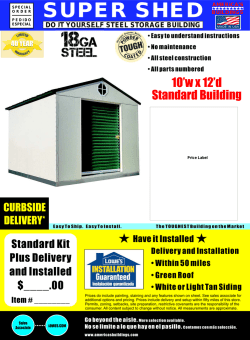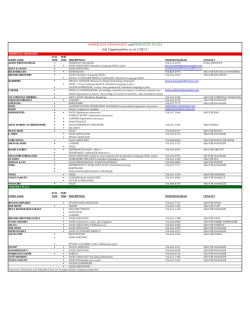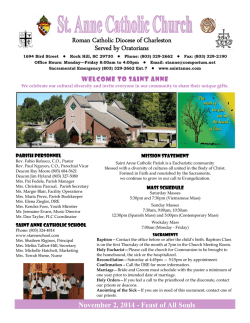
Download - Government Engineering College, Kozhikode
GEOTECHNICAL ENGINEERING II MODULE – I CHAPTER – 2 Site investigation and soil exploration Dr. K. M. Kouzer, Associate Professor in Civil Engineering, GEC Kozhikode SYLLABUS - Module I 2. Site investigation and soil exploration: objectives - planning - reconnaissance - depth and lateral extent of explorations -methods of subsurface exploration - test pits - Auger borings - rotary drilling –Types of soil samples-split spoon samplers- Standard penetration testhand cut samples- boring log - soil profilegeophysical methods (in brief). Dr. K. M. Kouzer, Associate Professor in Civil Engineering, GEC Kozhikode 2 OBJECTIVES OF SOIL INVESTIGATION ● Determination of – The nature of the deposits of soil – The depth and thickness of the various soil strata and their extent in the horizontal direction – The location of ground water and fluctuations in GWT – Engineering properties of the soil and rock strata by conducting laboratory tests – In-situ properties of soil by performing field tests ● Obtaining soil and rock samples from the various strata Dr. K. M. Kouzer, Associate Professor in Civil Engineering, GEC Kozhikode 3 Geotechnical Investigation Reconnaissance Preliminary Investigations Detailed Investigations Dr. K. M. Kouzer, Associate Professor in Civil Engineering, GEC Kozhikode 4 RECONNAISSANCE ● Inspection of the site and study of the topographical f t features p and other relevant records. ● Studyy of maps ● Collect details about proposed constructions ● Collect C ll t already l d existing i ti d t and data d then th examine i f for soils and geological conditions ● Collect details required for economic designs ● Helps in deciding future programme of site investigations, scope of work, methods of exploration to be adopted, types of samples to be taken and the laboratory testing and in in-situ situ testing. Dr. K. M. Kouzer, Associate Professor in Civil Engineering, GEC Kozhikode 5 Study of Maps ● Study of maps from Survey of India or Geological survey of India to get information regarding faults, folds, cracks, fissures, etc. Dr. K. M. Kouzer, Associate Professor in Civil Engineering, GEC Kozhikode 6 Folds Dr. K. M. Kouzer, Associate Professor in Civil Engineering, GEC Kozhikode Faults Dr. K. M. Kouzer, Associate Professor in Civil Engineering, GEC Kozhikode Aerial photography Dr. K. M. Kouzer, Associate Professor in Civil Engineering, GEC Kozhikode Satellite images Dr. K. M. Kouzer, Associate Professor in Civil Engineering, GEC Kozhikode PRELIMINARY INVESTIGATIONS ● To determine the depth, thickness, extent and composition iti off each h stratum t t att the th site. it ● The depth of bed rock and the ground water table is also determined. ● Generally in the form of test pits and few borings ● Tests are conducted with cone penetrometers and sounding rods to obtain information about the strength and compressibility of soils. ● Geoph Geophysical sical methods are used sed for locating the boundaries of different strata. Dr. K. M. Kouzer, Associate Professor in Civil Engineering, GEC Kozhikode 11 Detailed Investigations Direct Method ¾Trial Pits ¾Trenches ¾Auger Boring ¾Shell and Auger Boring ¾Wash Boring ¾Percussion Drilling ¾Rotary Drilling Semi-direct methods Indirect methods (Borings) Geophysical methods ¾Seismic Method ¾ ¾Electrical Resistivity Method Soundings or penetration tests ¾Standard Penetration Test (SPT) ¾Static Cone Penetration Test (SCPT) ¾D ¾Dynamic i C Cone P Penetration t ti T Testt (DCPT) Dr. K. M. Kouzer, Associate Professor in Civil Engineering, GEC Kozhikode 12 DIRECT METHOD TEST PITS ● Usually made for supplementing other methods or for minor structures ● Visual inspection of soil ● Personal feeling of soils ● Co Collection ec o o of so soil sa samples p es Dr. K. M. Kouzer, Associate Professor in Civil Engineering, GEC Kozhikode SEMI DIRECT METHODS Dr. K. M. Kouzer, Associate Professor in Civil Engineering, GEC Kozhikode 13 AUGER BORING ● For soils with sides of the hole can remain unsupported in dry state. state ● Hand operated – 3 to 5 m depths ● Power driven – up to 50 m depth HAND OPERATED AUGERS Dr. K. M. Kouzer, Associate Professor in Civil Engineering, GEC Kozhikode MACHINE OPERATED AUGERS Dr. K. M. Kouzer, Associate Professor in Civil Engineering, GEC Kozhikode 15 SHELL AND AUGER BORING ● Shell used for soil with sides of the hole cannot remain unsupported. ● B Boring i is i always l started t t d first fi t with ith augering and the shell is used for advancing the bore hole. ● Shell raised above the bottom of the hole and allow it to fall freely. p of the drop p cuts the The impact soil and pushes the soil in to the tube. ● After filled, shell is withdrawn and emptied. emptied Dr. K. M. Kouzer, Associate Professor in Civil Engineering, GEC Kozhikode 17 WASH BORING ● For soils which auger boring is not suitable ● For soils not mixed with gravel and boulders ● For collecting samples, samples replace drill bit with samplers l ● Change of rate of progress and change of colour of wash water indicate change in soil strata t t Dr. K. M. Kouzer, Associate Professor in Civil Engineering, GEC Kozhikode 18 PERCUSSION DRILLING ● Heavy drill bit suspended from a drill rod or a cable and is driven by repeated blows ● Water is added to facilitate the breaking of stiff sol or rock ● Not suitable for loose sand and is slow in plastic clays p y Dr. K. M. Kouzer, Associate Professor in Civil Engineering, GEC Kozhikode 19 PERCUSSION DRILLING TOOLS Dr. K. M. Kouzer, Associate Professor in Civil Engineering, GEC Kozhikode 20 ROTARY DRILLING ● Fast in rocks ● Drill bit fixed to the lower end of a drill rod is rotated by power ● Bentonite slurry y is forced under pressure through the drill rod and it comes up along the cutting soil ● Rock cores can be obtained by using g suitable diamond drill bits and core barrels Dr. K. M. Kouzer, Associate Professor in Civil Engineering, GEC Kozhikode ROTARY DRILLING Dr. K. M. Kouzer, Associate Professor in Civil Engineering, GEC Kozhikode 21 DEPTH OF EXPLORATION ● Governed by the depth of the influence zone which depends on the type of structure, intensity of loading, loading shape and disposition of the loaded area, th soilil profile the fil and d the th physical h i l characteristics of the soil. ● The depth upto which the stress increment due to superimposed loads can produce significant p g settlement and shear stress is known as the “Significant g Depth”. p PRESSURE BULB Dr. K. M. Kouzer, Associate Professor in Civil Engineering, GEC Kozhikode GUIDELINES FOR DEPTH OF EXPLORATION Sl. No. TYPE OF FOUNDATION DEPTH OF EXPLORATION ((i)) Isolated Spread Footing g or Raft 1.5 B (ii) Adjacent Footings with clear spacing < 2B 1.5 L Dr. K. M. Kouzer, Associate Professor in Civil Engineering, GEC Kozhikode 23 ADJACENT ROWS OF FOOTINGS Sl. No. TYPE OF FOUNDATION DEPTH OF EXPLORATION (iii) Adjacent Rows of Footings with clear spacing < 2B Adjacent Rows of Footings with clear spacing > 2B, but < 4B Adjacent Rows of Footings with clear spacing P 4B 45B 4.5 3B 15B 1.5 Dr. K. M. Kouzer, Associate Professor in Civil Engineering, GEC Kozhikode PILE AND WELL FOUNDATIONS Sl. No. TYPE OF FOUNDATION DEPTH OF EXPLORATION ((iv)) Pile and Well Foundation 1.5 x Width of Structure from the bearing g level (Toe of pile or bottom of well) Dr. K. M. Kouzer, Associate Professor in Civil Engineering, GEC Kozhikode ROAD CUTS Sl. No. (v) TYPE OF FOUNDATION Road Cuts DEPTH OF EXPLORATION Bottom width of the cut (B) Dr. K. M. Kouzer, Associate Professor in Civil Engineering, GEC Kozhikode FILLS Sl. No. (vi) TYPE OF FOUNDATION Fills DEPTH OF EXPLORATION 2 m below GL or height of fill (H) whichever is greater Dr. K. M. Kouzer, Associate Professor in Civil Engineering, GEC Kozhikode SOWERS AND SOWERS (1970) FORMULA ● Empirical Relationship for Multistoreyed Buildings D = C (S) 0.7 where D = Depth of exploration C = Constant = 3 for Light steel buildings & Narrow concrete bldgs = 6 for Heavy Hea Steel bldgs & Wide Concrete bldgs. bldgs S = No. of storeys Dr. K. M. Kouzer, Associate Professor in Civil Engineering, GEC Kozhikode 29 Spacing of Borings ● The number and spacing of bore holes or trial pits will depend upon the extent of the site and nature of structures coming on it. ● For a compact building site covering an area of about 0.4 hectre, one bore hole or trial pit in each corner and one in the centre. ● For smaller buildings, buildings one bore hole or trial pit in the centre. Dr. K. M. Kouzer, Associate Professor in Civil Engineering, GEC Kozhikode 30 Sl. No. Nature of project Spacing 1. Highways 300 to 600 m 2. Earth dams 30 to 60 m 3. 3 Borrow o o p pits s 30 to o 120 0m 4 4. Multi-storey Multi storey buildings 15 to 30 m 5 5. Single storey factories 30 to 90 m m. Dr. K. M. Kouzer, Associate Professor in Civil Engineering, GEC Kozhikode SAMPLES ● DISTURBED SAMPLES – REPRESENTATIVE SAMPLES • • • • GRAIN SIZE ANALYSIS ATTERBER LIMITS SPECIFIC GRAVITY CHEMICAL ANALYSIS – NON NON-REPRESENTATIVE REPRESENTATIVE SAMPLES • Mixture of materials from various strata or some mineral constituents lost ● UNDISTURBED SAMPLES • • • • SHEAR STRENGTH PARAMETERS CONSOLIDATION PARAMETERS IN-SITU DENSITY AND WATER CONTENT COEFFICIENT OF PERMEABILITY ● BLOCK OR CHUNK SAMPLES Dr. K. M. Kouzer, Associate Professor in Civil Engineering, GEC Kozhikode 32 SAMPLERS ● Based on Mode of operation – Open Drive Samplers • Thick wall type – Split Spoon Sampler (SPT S Sampler) l ) • Thin wall type yp – Shelby y Tube Sampler p ((UDS Sampler) – Stationary Piston Sampler – Rotary Sampler Dr. K. M. Kouzer, Associate Professor in Civil Engineering, GEC Kozhikode 33 SPLIT SPOON SAMPLER Dr. K. M. Kouzer, Associate Professor in Civil Engineering, GEC Kozhikode 34 THIN WALLED SAMPLER Dr. K. M. Kouzer, Associate Professor in Civil Engineering, GEC Kozhikode SEALING METHODS Dr. K. M. Kouzer, Associate Professor in Civil Engineering, GEC Kozhikode PISTON SAMPLER Dr. K. M. Kouzer, Associate Professor in Civil Engineering, GEC Kozhikode OSTERBERG PISTON SAMPLER Dr. K. M. Kouzer, Associate Professor in Civil Engineering, GEC Kozhikode ROTARY SAMPLER Dr. K. M. Kouzer, Associate Professor in Civil Engineering, GEC Kozhikode BLOCK OR CHUNK SAMPLES Dr. K. M. Kouzer, Associate Professor in Civil Engineering, GEC Kozhikode 39 SAMPLER PARAMETERS ● Inside Clearance (CI) – Should be between 1 to 3 % – All Allows for f elastic l ti expansion i off the soil as it enters the tube, reduces frictional drag on the sample from the wall of the tube. ● Outside Clearance (Co) – The outside clearance should not be much greater than the inside clearance. – This facilitates the withdrawal of the sampler from the ground. Dr. K. M. Kouzer, Associate Professor in Civil Engineering, GEC Kozhikode 41 SAMPLER PARAMETERS ● Area Ratio (Ar) − Should be kept as low as possible. − ≤ 20% for stiff formations and ≤10% for soft sensitive clays. Dr. K. M. Kouzer, Associate Professor in Civil Engineering, GEC Kozhikode 42 University Questions ● Comment on the area ratios of the following samples: Outer Dia (mm) Inner Dia (mm) (i) Split spoon sampler 50 25 (ii) Drive tube 100 90 (iii) Shelby tube 50 47 Solution : Outer Dia (mm) Inner Dia (mm) Area Ratio (i) Split spoon sampler 50 25 300 % (ii) Drive tube 100 90 23.46 % (iii) Shelby Sh lb tube t b 50 47 13 17 % 13.17 Dr. K. M. Kouzer, Associate Professor in Civil Engineering, GEC Kozhikode 43 Rock Coring Parameters Core Recovery = Length of the core recovered Total Core Run R n Length Dr. K. M. Kouzer, Associate Professor in Civil Engineering, GEC Kozhikode 44
© Copyright 2026


